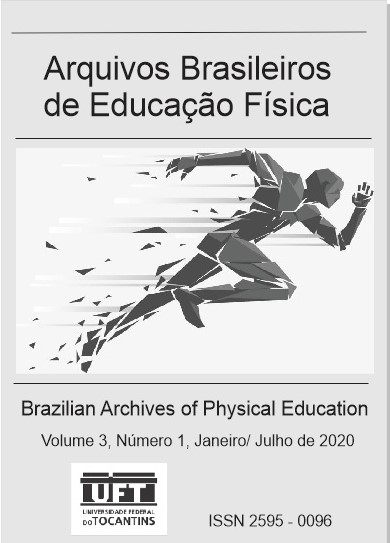Qual modelo de intervalo de descanso utilizado pelos praticantes de treinamento de força?
Um estudo piloto
DOI:
https://doi.org/10.20873/abef.2595-0096.v3n1p2935.2020Keywords:
Desempenho, Recuperação, Força muscularAbstract
Introdução: O intervalo de descanso entre as séries é uma das variáveis metodológicas do treinamento de força a ser manipulada. No entanto, pouco se sabe qual o modelo de intervalo utilizado habitualmente pelos praticantes de treinamento de força. Objetivos: Verificar qual o modelo de intervalo de descanso utilizado pelos praticantes de treinamento de força e analisar se nível de experiência dos indivíduos e a orientação está relacionado com o intervalo de descanso. Métodos: Foi aplicado um questionário composto por 29 perguntas. Resultados: Os achados revelaram que 80% (44) empregam o modelo fixo e 20% (11) utilizam o autossugerido. Não houve associação entre experiência, orientação e o controle de intervalo de descanso. Conclusão: A maioria dos praticantes de treinamento de força utilizam modelos fixos e a experiência, bem como a orientação não estão relacionadas.
References
Fleck SJ, Kraemer WJ. Fundamentos do treinamento de força muscular. 4th ed. Porto Alegre; 2017.
Suchomel TJ, Nimphius S, Stone MH. The importance of muscular strength in athletic performance. Sport Med. 2016;46(10):1419–49.
Grgic J, Schoenfeld BJ, Skrepnik M, Davies TB, Mikulic P. Effects of rest interval duration in resistance training on measures of muscular strength: A systematic review. Sport Med. 2017;48.
Grgic J, Lazinica B, Mikulic P, Krieger JW, Schoenfeld BJ. The effects of short versus long inter-set rest intervals in resistance training on measures of muscle hypertrophy: A systematic review. Eur J Sport Sci. 2017;17(8):983–93.
de Souza TP, Fleck SJ, Simão R, Dubas JP, Pereira B, Pacheco EM de B, et al. Comparison between constant and decreasing rest intervals: Influence on maximal strength and hypertrophy. J Strength Cond Res. 2010;24(7):1843–50.
Mcleod JC, Stokes T, Phillips SM. Resistance exercise training as a primary countermeasure to age-related chronic disease. Front Physiol. 2019;10.
ACSM. Progression models on resistance training for healthy adults. Am Coll Sport Med. 2009;689–708.
Senna GW, Rodrigues BM, Sandy D, Scudese E, Bianco A, Dantas EHM. Heavy vs light load single-joint exercise performance with different rest intervals. J Hum Kinet. 2017;58(1):197–206.
Schoenfeld BJ, Pope ZK, Benik FM, Hester GM, Sellers J, Nooner JL, et al. Longer interset rest periods enhance muscle strength and hypertrophy in resistance-trained men. J strength Cond Res. 2016;30(7):1805–12.
Senna G, Scudese E, Martins CL, Scartoni FR, Carneiro F, Alves JCC, et al. Rest period length manipulation on repetition consistency for distinct single-joint exercises. J Exerc Physiol. 2016;19(5):93–102.
Senna GW, Willardson JM, Scudese E, Simão R, Queiroz C, Avelar R, et al. Effect of different interset rest intervals on performance of single and multijoint exercises with near-maximal loads. J Strength Cond Res. 2016;30.
Fink J, Kikuchi N, Nakazato K. Effects of rest intervals and training loads on metabolic stress and muscle hypertrophy. Clin Physiol Funct Imaging. 2016.
Ratamess NA, Chiarello CM, Sacco AJ, Hoffman JR, Faigenbaum AD, Ross RE, et al. The effects of rest interval length on acute bench press performance: the influence of gender and muscle strength. J strength Cond Res. 2012;26(7):1817–26.
Silva W, Viana R, Santos D, Vancini R, Andrade M, Lira C de. Profiling Rest Intervals between Sets and Associated Factors in Resistance Training Participants. Sports. 2018;6(4):134.
Fabiana Goessler K, Doederlein Polito M. Effect of fixed and self-suggested rest intervals between sets of resistance exercise on postexercise cardiovascular behavior. Rev Bras Cineantropometria e Desempenho Hum. 2013;15(4):467–75.
De Salles BF, Polito MD, Goessler KF, Mannarino P, Matta TT, Simão R. Effects of fixed vs. self-suggested rest between sets in upper and lower body exercises performance. Eur J Sport Sci. 2016;16(8):927–31.
Zaccaron R, D’Ely RC de SF, Xhafaj DCP. Estudo piloto: um processo importante de adaptação e refinamento para uma pesquisa quase experimental em aquisição de L2. Rev do GELNE. 2018;20(1):30–41.
Downloads
Published
How to Cite
Issue
Section
License
Proposal for Copyright Notice Creative Commons
1. Policy Proposal to Open Access Journals
Authors who publish with this journal agree to the following terms:
A. Authors retain copyright and grant the journal right of first publication with the work simultaneously licensed under the Creative Commons Attribution License that allows sharing the work with recognition of its initial publication in this journal.
B. Authors are able to take on additional contracts separately, non-exclusive distribution of the version of the paper published in this journal (ex .: publish in an institutional repository or as a book), with an acknowledgment of its initial publication in this journal.
C. Authors are permitted and encouraged to post their work online (eg .: in institutional repositories or on their website) at any point before or during the editorial process, as it can lead to productive exchanges, as well as increase the impact and the citation of published work (See the Effect of Open Access).

